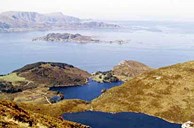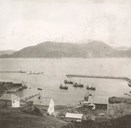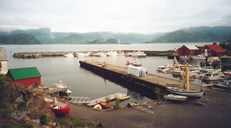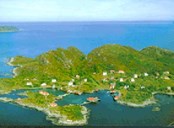Velom i Sildene
Jan Olson Sørpoll (1790-1884) married Johanne, daughter of teacher Samuel Jonson Silda and then settled down at Søre Silda. Jan was much in demand as a pilot, and he worked as a pilot until he turned 68. Villum Janson Silda (1829-1862) became a pilot and worked together with his father, and he was known locally as "Velom i Sildene". Villum was a big and strong man, and also a good dancer and fiddler. But he was best known for his deeds as a pilot. He tended to be a little careless. Once he took a vessel off Furestaven and piloted it all the way to Trondheim although he had never been so far north before. Velom died on Boxing Day 1862, at the early age of 32.
The schooner "Marie" from Drammen
On 14 December 1862, Velom heard that a ship was lying west off Stad and signalled for a pilot. The ship was loaded with coal from England en route to Trondheim. Storms had been raging and the crossing of the North Sea had been extremely rough. The captain, Otto Schmidt, therefore wanted the ship to get into calmer waters at Silda over Christmas so the crew could get a chance to repair some of the damage. The captain himself went south to Vågsberget where he could spend the Christmas holiday with the trader Chr. I. Berg. The harbour at Silda was known as a "waiting harbour" as far back as the Viking Age. Allegedly, the Norwegian earl Skule Jarl was once waiting in this harbour for better weather on his way to Trondheim.
Christmas dance in the pilot's home
The northern harbour was a natural harbour encircled by two islets and two skerries. The harbour was sheltered from wind and weather, but not from the surge from northwesterly winds. The present jetties were built after the tragic episode described below. That evening there was also a Danish "jekt" in the harbour. The schooner crew was invited ashore to the home of the pilot, who hosted the dance that time. Later in the evening, the wind increased from the northwest and it started to snow as well. The crew thought it best to return to the ship to look after it. One hour after midnight, Velum was asked to come onboard. The crew feared that the mooring lines would break. The storm turned into a hurricane, and people had never experienced such a strong wind before. For many years afterwards, people used to compare bad weather with "when Velom i Sildene lost his life."
"Marie" broke adrift
After Velom had come onboard, the land mooring line broke and the anchor was beginning to lose its grip. The schooner now drifted out of the harbour and was probably damaged on a submerged rock just outside the harbour. Immediately outside the harbour it was so deep that the anchor did not reach the bottom. "Marie" and the crew now drifted eastward into the Sildefjord. Velom knew these waters like the back of his hand and he full well realized what they were up against. Most likely he tried to hoist some sail so he could steer "Marie" in between Barmen and Venøya. If they only could manage to get east of Barmen, the waters would be calmer and thus both ship and crew could be saved. This did not happen.
Probably ran aground at Mannebeinet
The crew probably tried to get a lifeboat on the water, but they failed. The lifeboat was found at Nordpollen full of seawater, but in an upright position. Two caps were found on the floorboards, which puzzled people. The cabin with the compass was found between Sandvika and Flister. "Marie" most likely ended her days at Mannebeinet on the island of Venøya. Fishermen have found pieces of coal, wood, and iron in their nets in this area. In recent years, divers have tried to locate the shipwreck, but nothing has been found. The water deepens quickly in this area.
Engaged to Elisabet
Velom was engaged to Elisabet Flatrake, and they were to be married in spring. At daybreak the following morning, Elisabet and four others rowed in a big rowboat to look for her fiancé. They looked along the shores of Venøya and on other beaches in the area. Darkness fell and they still had not found anything. On the way home Elisabet sat in the rowboat full of despair at the loss of Velum. It was a sad and difficult time for the people of Silda. Velum had been a unifying element in the village. "Marie" had run aground at the worst possible spot in this area. If the schooner had hit land a little further to the east, she would have landed on a flatter rock and shallower water. Then the ship would probably not have broken up. After the drowning tragedy of Velum, there have not been any more pilots at Silda.






